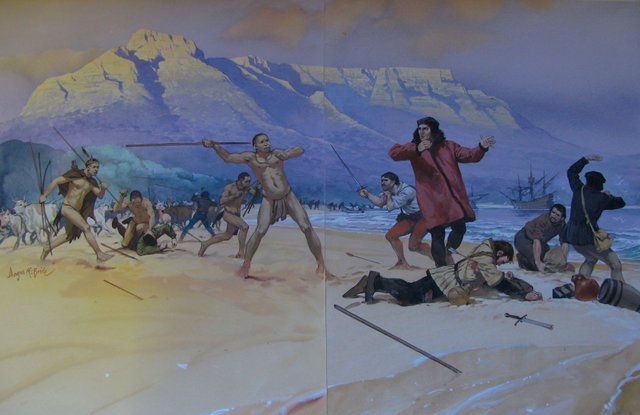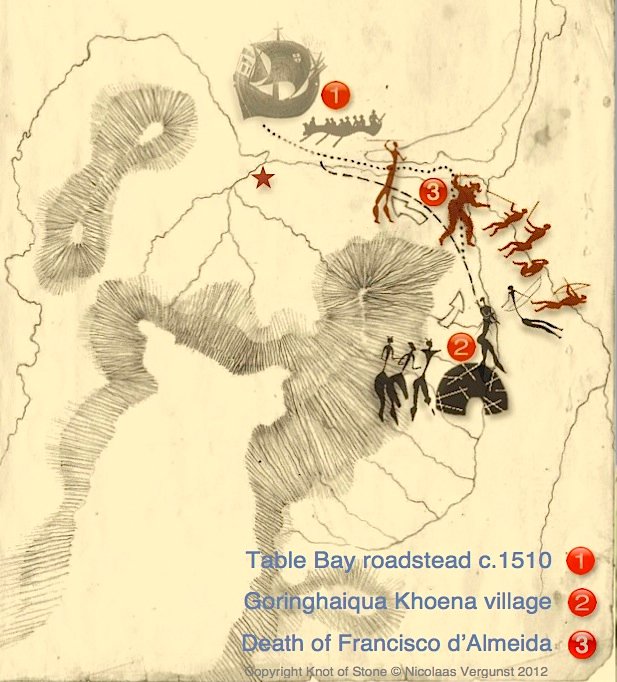SOUTH AFRICAN HISTORY: Francisco d'Almeida's death at the Cape of Good Hope
On 1 March 1510, the battle of the Goringhaiquas became the earliest known battle site in South Africa and first recorded war memorial. The battle also changed the flow of history and delayed the settlement of Europeans for more than 100 years.
On this date the Francisco d’Almeida, former Viceroy of Portuguese territories in India, was killed in a skirmish with the local Khoikhoi tribe – the Goringhaiquas - at Aguada de Saldanha, the Portuguese name for Table Bay.

After bringing the Indian ocean basin under control of Portugal, d’Almeida was leaving India in the closing months of 1509. Portugal’s Estado da Índia then spanned an entire ocean, stretching from the Cape of Good Hope in South Africa to the southern tip of India - Cape Comorin.
While boarding his ship, the Garça, a woman sorcerer passed him and predicted him that he would not pass beyond the Cape of Good.
On his arrival in Table Bay (Aguada de Saldanha) it was recorded that d’Almeida said to his attendants: “Now God be praised, the witches of Cochin are liars.”
As soon as d’Almeida dropped anchor, several curious Goringhaiqua tribe members came down to the beach. They befriend the strangers who collected water and wood. The new relationship led to several requests to visit the nearby village which d’Almeida first rejected, but after awhile gave permission when his men claimed they could barter sheep or cattle for the journey home. The Goringhaiqua village was at the foot of Devil’s Peak where the University of Cape Town is now situated.
A party was sent out but returned bruised and bloody-faced after a quarrel with the Khoi. They demanded a disciplinary party to be sent out and to teach the Khoi a lesson. D’Almeida reluctantly agreed to the request.
Early the next morning d’Almeida lead a party to the Goringhaiqua village. Before they could reach it, some of the men broke away and ran ahead.
They found the village deserted and started to pillage it.
During the chaos, one sailor was killed by a passing compatriot. When the news reached d’Almeida, he tried the call off the expedition, but it was too late. The Goringhaiquas has gathered their cattle and began to drive them on the heels of the retreating sailors. Those who were not stampeded, reach the beach with d’Almeida.
Unfortunately, the boats were already moved to the water filling point, and the men found themselves trapped between the sea and soft sand dunes.
Here, at the estuary of the Salt/Liesbeeck River, Almeida and his compatriots were trapped and killed.

When the news of d’Almeida death reached King Manual of Portugal, he ordered a day of mourning. Based on his superstition he forbade his ships from calling at the Cape of Good Hope again. He believed that the fallen sons of Portugal protected his realm and, allegedly, added: “as long as his bones are there, all is safe.”
After this incident, fearing more attacks, the Portuguese did not care to take possession of Africa’s southernmost coast.
It was only in the mid-17th century that Dutch settlers established themselves at the Cape.
Today more and more historians start to question the reason for d’Almeida’s visit to the Goringhaiqua village – Why did he need to go to the village?
The village lay a few hours of walk from the sea, and d’Almeida was already 60 years old and not in good health. The further question is, was it a disciplinary expedition?
It looks like the facts pointing to a conspiracy against d’Almeida by his people to get him murdered by the Khoi.
They convinced him to go ashore and then provoked the Khoi to attack. When the attack happened, they ensured that there was no escape plan which caused d’Almeida and his men to die on the beach at the Cape of Good Hope. This might also be the reason why the survivors elected Jorge Barreto and not Almeida’s obvious successor, Jorge de Mello Pereira, to report on the event back in Lisbon.
Sources:
http://www.capetourism.co.za/info-cape-town/general-info/early-cape-cultural-history.html
http://www.sahistory.org.za/dated-event/jan-van-riebeeck-urged-vryburgers-free-burghers-starts-peace-negotiations-kaapmans-khoi-
http://www.knotofstone.com/2012/03/murder-memory-and-bones/
http://www.knotofstone.com/francisco-d%E2%80%99almeida-and-walter-johannes-stein/
http://www.knotofstone.com/2012/04/first-encounters-early-conflicts-and-forgotten-beaches-part-2/
http://www.knotofstone.com/2012/02/south-africas-first-recorded-battle-site-rediscovered/
Hi @krabgat
Today I learned something of the history that I did not know.
Then my article was worth the effort, tx.
Fascinating... set back development in the Cape for 100 years. {grin}